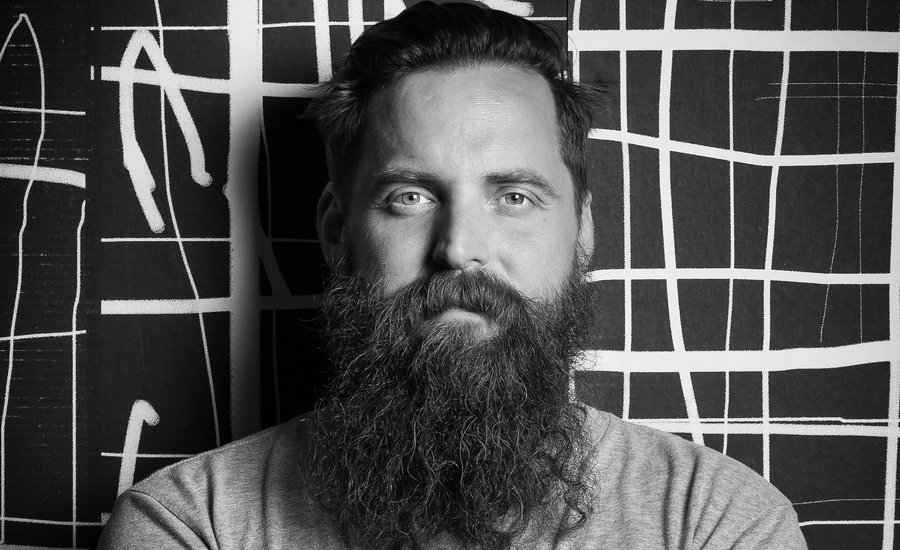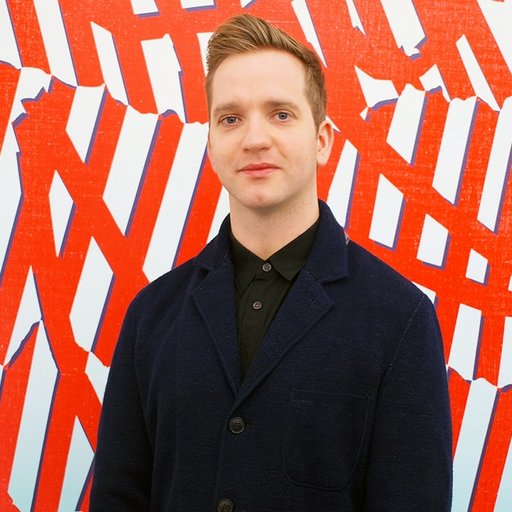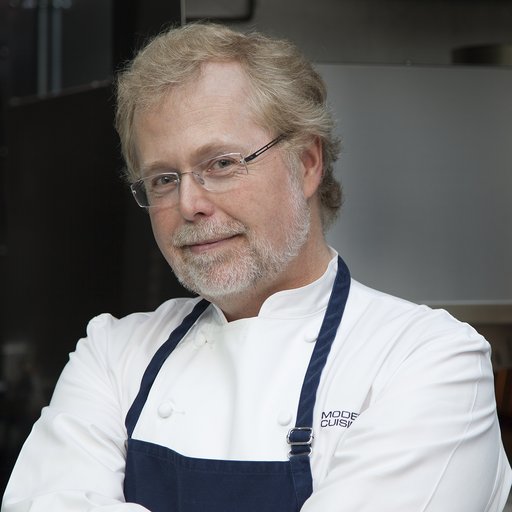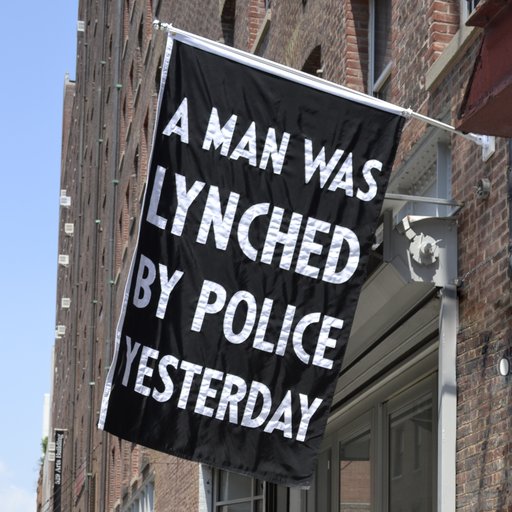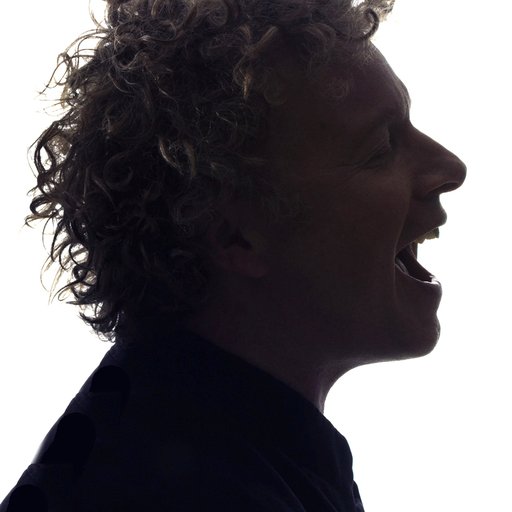Aaron Curry’s upcoming show at Michael Werner is being billed as his “first exhibition devoted to paintings New York”—but don’t be fooled. While the Los Angeles-based artist has achieved renown for his Modernist-inspired sculptures made using materials ranging from cardboard and wood to steel and concrete—and often rendered in neon colors that would fit right in at an EDM festival—painting has been a central reference point to his work ever since he left his hometown of San Antonio, Texas, to learn under the Chicago Imagists at the School of the Art Institute of Chicago.
His sculptures have gone on to be featured in shows at the Rubell Collection, the Hammer Museum, and Lincoln Center, building a loyal following of collectors along the way. Now, in recent shows at Werner’s London location as well as David Kordansky Gallery in his adoptive home of L.A., Curry is returning to his painterly roots. The results—predictably enough, given his penchant for mixing skate and sci-fi motifs with a healthy dose of art historical touchstones—are decidedly out of this world.
In advance of his Werner show (on view from September 9 to October 29) Artspace’s Dylan Kerr phoned Curry at his home studio to find out why he's having so much fun with paint on canvas these days.
What do you recall as your early art influences growing up in San Antonio? You’ve said before that you drew a lot as a child, but what were the things that drew you to your current, weird way of working?
I didn’t grow up around art—my family wasn’t involved with it or anything like that—so what I was drawing was album covers. I grew up in the '70s, so as a kid I was a fan of KISS and Iron Maiden album covers, anything that had an image. It all came from the music at first.
I got interested in BMX and skateboarding later. Skateboarding in the '80s was so visual—the graphics on the boards, the t-shirts, the stickers. I drew a lot of that, too. I applied to go to art school after high school, and I went to Chicago and got opened up to a lot of different things.
What attracted you to Chicago as a high school student?
I had no idea. I didn’t know much. I think New York seemed a bit scary to me, coming from a suburb in Texas. Chicago had a great reputation. I don’t know if it actually was the best school, but everybody thought it was the best art school at the time. I thought, “Oh, I’ll try that place out.” I didn’t really know about any Chicago artists or anything like that, at the time.
What did you find when you got to Chicago?
I remember I stumbled upon a Peter Saul show while walking around the gallery area at night. I was like, “Who is that guy?” I went the next day when the gallery opened, asked some questions, walked around. There was a lot Chicago Imagist work shown, like Roger Brown, Ed Paschke, and Karl Wirsum. I found out that a lot of them taught at my school, which was great. I took Karl’s class for a really long time, and another with Barbara Rossi. Ray Yoshida and Jim Nutt were only teaching grad students, so unfortunately I didn’t get to study with them.
Looking back, do those people stick out as really big influences on the work you’re making today? Who else would you cite as an influence on that level?
They’re definitely part of my makeup, but I’ve gone through a lot of stages. I’ve gone through a Rauschenberg phase where I was just obsessed with the early works and a lot of his cardboard pieces. I’ve gone through an Arp phase, and Picasso of course—a lot of Surrealism.
I’m kind of a junkie—I really like art. Like, I love it. I’m all over the place, but I definitely think that those Chicago artists had a huge impact on me, because it somehow related to where I was coming from—skateboard graphics and things. There was a graphic quality to it that was easy for me to pick up on.
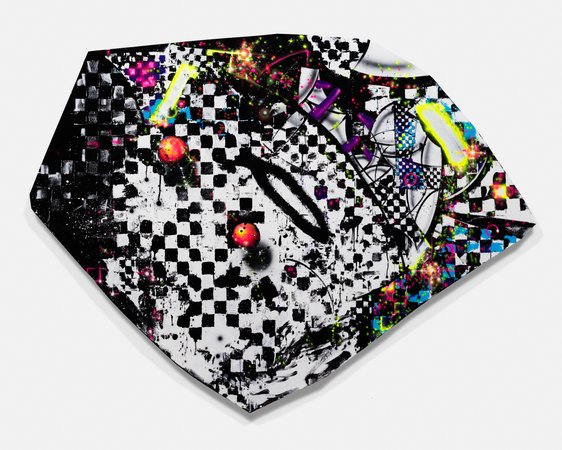 Untitled, 2016
Untitled, 2016
Would you say that your interest in collage and the rougher aesthetic that you’re known for comes from skate culture?
I think because I learned about art history in my 20s, I was still filtering it through all of that. I had to relate it to something, so I related the Imagists to this graphic quality of skateboard culture. I think I always put all of that through this filter that I had created as a kid. I’m not checking out skateboard graphics and stuff now—it’s just what I grew up liking, and it’s part of who I am as an artist. It comes out if I want it to or not.
Nowadays you’re known as a Los Angeles artist. What prompted your move to L.A. from Chicago?
There was a show early on when I first got to Chicago called “Helter Skelter.” The catalogue introduced me to Mike Kelley, Paul McCarthy, Liz Larner, and Jim Shaw. I didn’t know about any of those guys, and that was like, “Woah. This is really cool.” I was taken by how freaky it was—it’s just weird art. It just seemed so different from what I saw coming out of New York.
From there, I developed an interest in a lot of the L.A. artists. I dropped out of school because I didn’t have the money in the early ‘90s. I ended up having a really big bill, and it took me six years to pay it off. I ended up going back to school and finishing one year. At that time I was really interested in what was going on here in L.A., and all the artists I was looking at were teaching. That was really the reason to come study here, because there were people I liked that were teaching out here. I wasn’t drawn by L.A. at all really—it wasn’t until I moved there that I got appreciation for the city.
It’s a funny biographical detail for you—you’re now so strongly associated with L.A., but you didn’t grow up there or even move there until you were an adult, and then for very cogent, art-centric reasons. Have you embraced this association with L.A.? Is it something you’re proud of?
Yeah, I definitely do. I feel like an L.A. artist. It wasn’t until grad school that I really matured, and I feel like I became a mature artist here. Maybe I was a late bloomer. I’m really happy to be an L.A. artist, but I’d be a different artist for sure if I hadn’t studied in Chicago.
What was it like studying under those L.A. artists right at the time that they were really starting to achieve national, and eventually international, recognition?
It was great. They were generous and I had great professors and met some great people there. It’s interesting—the market was an evil thing at the time. It was really frowned upon to talk about it and what was going on outside of school. It was really intense academic art program.
How did that tension manifest in the classroom?
It was weird—people didn’t talk about the market, and if they did, it was always a really negative thing. If I were to teach I think it would be important to acknowledge it, especially when you’re paying $100,000 to go to grad school. I think it would have helped to explain to young artists the situation after graduation—getting a gallery, what that relationship is like, things like that
You see that as something that ought to be part of an art education?
I think it should be. I don’t think it should be a class, I just think teachers should talk to their students. In grad school, it’s more of like an hour that you spend one-on-one with the teacher, a lot of meetings, and I think it would be good for them to give the students some advice. It’s a really messy thing—it’s different than making art. It’s like learning a whole new practice. Art is something that can be great, and all the other stuff is kind of a drag.
It seems like L.A. is constantly positioned as being in the midst of an arts renaissance, despite the fact that the city has been an artists’ hub for decades. What do you think about what’s been going on these past several years, with tons of galleries opening up and the resurgence of this reputation as this place for emerging artists?
It’s funny because when I was first out of grad school, I was in a show in the Rubell Collection, and everybody kept talking about L.A. Now I feel like so many people are moving here. As I’ve gotten older I tend to just stay in my studio, which is at my house. I hardly ever go out, so I don’t know that I have a really good, solid perspective on it. I do feel like it’s losing a little bit of its spunkiness, which is unfortunate.
How so?
Like I said, I probably shouldn’t have much of an opinion on it, but I just feel like there was more of an embrace of periphery artists, of the freaks, of people that are making good art that aren’t part of the system. It’s become much more of an art mecca or something, which of course means that a lot of the really interesting things fall through the cracks.
 Dark Matter Matter, 2016
Dark Matter Matter, 2016
Let’s switch to the new stuff—your upcoming painting show at Michael Werner. For the most part, when people think about your art they’re thinking about your sculptures and collages. Your turn to painting seems like a marked change in focus, but painting wasn’t entirely foreign to what you were doing within those other media, right? What’s your personal history with painting?
Painting was really the first thing I did. I drew all the time as a kid, and when I went into undergrad, I just painted. It really wasn’t until right before graduate school that I started making sculptures.
At the tail end of the last year of undergrad, I had started making these pieces using musical equipment. I was really interested in sound, so I’d make the canvases that had pickups behind them that would plug into amplifiers and would pick up the ambient sound. Then I got really specific—it had to be a Marshall stack, it had to be a certain amplifier or a certain cord. I was still making formal decisions, but it was slowly coming off the wall. I was trying to deal with something different than just the two-dimensional plane. I was getting away from image-making in my art and I realized, at the end of the day, I was making sculptures.
When I abandoned the idea of using sound—I felt like it’d be interesting to have the sculpture perform on its own—it started being its own weird thing in space. Eventually, I started introducing paint back into the work. I was painting on the sculptures, and I was doing these paintings on paper. Somehow it still they felt like they were physical, because they curled up off the wall—they still related more to sculpture.
A lot of my sculptures have painted surfaces, and somehow I felt like I could have more fun going back to painting on canvas now.
How so?
I don’t know why. It’s weird—I didn’t really care what it was for a long time. I was just making. I started just painting on canvas again about two years ago and just not showing anybody. It was nice because I felt like I could just make whatever I wanted without being embarrassed or held responsible for them.
What prompted this return to painting two years ago?
I’d been burnt out. I felt like I had a lot of creative energy that I needed to put somewhere else—I had a blockage or something. I started playing music a lot more, too.
A blockage with the sculpture?
Yeah, with the sculpture. I changed the material, which kept me excited for a while, and then I really just had to put it aside and started focusing on painting. Now, I’ve kind of gone back into making sculpture. Creatively, I needed break from it. It felt really challenging to go back into painting and make what I thought would be a really good painting.
In terms of your own mindset, is your time in the studio working on paintings significantly different compared to working on sculptures?
Right now, I still have a woodshop studio in East L.A. that I have to drive to. It’s a different experience in my studio at home, where I’d just kind of wake up with my coffee and come in. I’ve working a lot for this show, and it’s kind of great. I start early in the morning—five or six—and work until 10 at night. I’m getting older so I think I need less sleep, which is good [laughs]. I can get more done.
It’s funny—I don’t know if this is good for an interview, but I used to drink a lot, like every day. I was a heavy drinker. I wouldn’t even have done this interview sober back in the day. It was awful. I stopped, and I couldn’t make these paintings drinking.
Why is that? What was about drinking that got in the way of the paintings?
The reason I called this show “Headspace” is because I allowed myself to get into a certain headspace with these. It’s this great thing you can do an artist—it’s almost like being on drugs in a way, a kind of euphoria. I think you can get there with sculpture, but it’s a lot more of a physical thing. When I was drinking, I couldn’t get there with the paintings at all. I was just too slurry, you know?
But the sculpture was somehow easier for you to work on in that mode?
Yeah. I embrace it, in a way. I want it to almost feel drunk, to have these clumsy marks or a clumsy feel to it.
 My Brain Is an Antenna, 2016
My Brain Is an Antenna, 2016
What was your approach to making the paintings in this exhibition?
With this show, I really just allowed myself to make paintings. Some of them look like maybe the images were worked out beforehand, but none of them were. I draw all the time so I work out ideas there, but they mostly get stored away in my head. I started with a blank canvas, and some of them I painted over six times. I worked on the show for about eight months.
What kinds of things were you referencing in this show? As we’ve already mentioned, you pull from both pop culture and art history.
With a lot of those references, I think of as almost the same thing. It’s like having different sorts of brush strokes, different colors on the palette, different moments to use different ways of painting, and just playing around with it all. I’m not directing the viewers or trying to lead them in a certain direction.
This show incorporates themes from science fiction and cosmology. How did you get interested in those subjects?
That was a direct response to living in Los Angeles. We’ve had such a bad drought. It’s intense, and I’m thinking a lot about the change of the Earth. I got nerdy about things, reading Carl Sagan just for my own interest. And I’m a big sci-fi fan.
I’ve been thinking a lot about cosmological orgies, about matter being created—they look like these messy sex scenes happening in space, but they’re really just abstractions. It’s just a platform for me to have fun making paintings.
What are some other reference points for these works?
I was really obsessed with these late Picabia paintings. There’s some of them where they centralize compositions, and I kind of like working off of that idea, what it means to take this modernist compositional construction and start from there. Some of the works are in smaller rectangles—I was kind of using that just sort of as a place to start, but I think if you look at them, probably no one would ever pick up on that. These are all just things I like—somehow they end up making work.
What’s the next step for you? Do you see yourself continuing with these paintings? Do you see yourself moving back into showing sculpture?
I’ve been doing these smaller metal sculptures that I’m really excited about. They’re playing with machining engine metal, different things like that. Right now, I’m getting really excited about painting, actually. After I was done with this show, I was kind of freaking out, because I was like, “Holy shit. What do I do?” So I got some new things going and started painting again. I have a lot of excitement and new ideas now.











